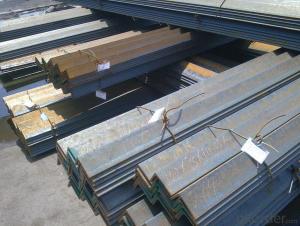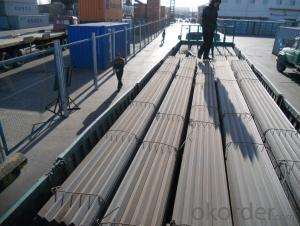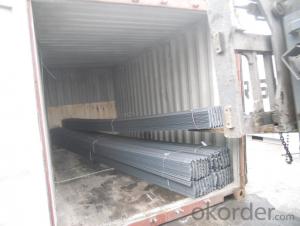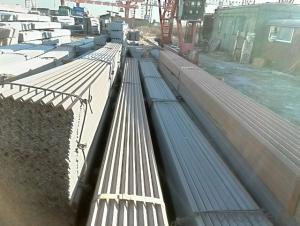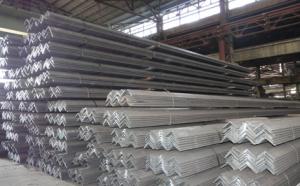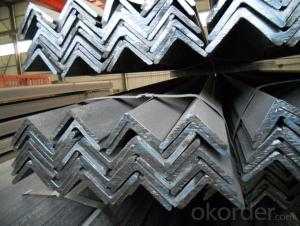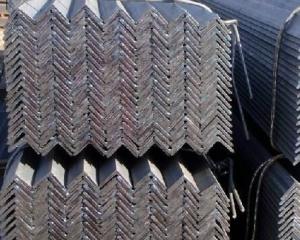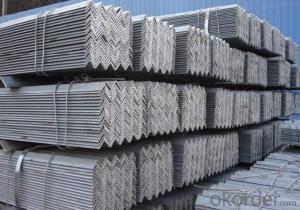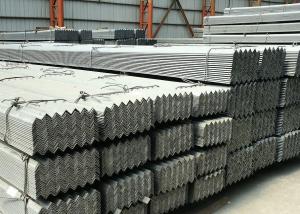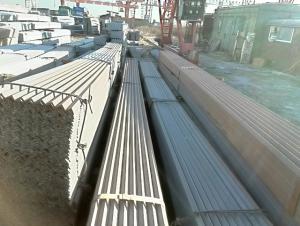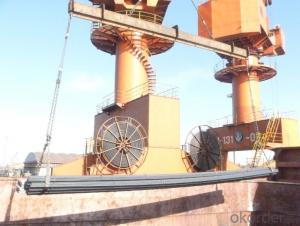Supply Hot Rolled Angle Steel for Transmission Towers
- Loading Port:
- Tianjin
- Payment Terms:
- TT OR LC
- Min Order Qty:
- 25 m.t.
- Supply Capability:
- 20000 m.t./month
OKorder Service Pledge
OKorder Financial Service
You Might Also Like
Specification
OKorder is offering high quality Hot Rolled Steel Angle at great prices with worldwide shipping. Our supplier is a world-class manufacturer of steel, with our products utilized the world over. OKorder annually supplies products to European, North American and Asian markets. We provide quotations within 24 hours of receiving an inquiry and guarantee competitive prices.
Product Applications:
Hot Rolled Steel Angles are ideal for structural applications and are widely used in the construction of buildings and bridges, and the manufacturing, petrochemical, and transportation industries.
Product Advantages:
OKorder's Steel Angles are durable, strong, and resist corrosion.
Main Product Features:
· Premium quality
· Prompt delivery & seaworthy packing (30 days after receiving deposit)
· Corrosion resistance
· Can be recycled and reused
· Mill test certification
· Professional Service
· Competitive pricing
Product Specifications:
Manufacture: Hot rolled
Grade: Q195 – 235
Certificates: ISO, SGS, BV, CIQ
Length: 6m – 12m, as per customer request
Packaging: Export packing, nude packing, bundled
Sizes: 25mm-250mm | ||
a*t | ||
25*2.5-4.0 | 70*6.0-9.0 | 130*9.0-15 |
30*2.5-6.6 | 75*6.0-9.0 | 140*10-14 |
36*3.0-5.0 | 80*5.0-10 | 150*10-20 |
38*2.3-6.0 | 90*7.0-10 | 160*10-16 |
40*3.0-5.0 | 100*6.0-12 | 175*12-15 |
45*4.0-6.0 | 110*8.0-10 | 180*12-18 |
50*4.0-6.0 | 120*6.0-15 | 200*14-25 |
60*4.0-8.0 | 125*8.0-14 | 250*25 |
FAQ:
Q1: Why buy Materials & Equipment from OKorder.com?
A1: All products offered byOKorder.com are carefully selected from China's most reliable manufacturing enterprises. Through its ISO certifications, OKorder.com adheres to the highest standards and a commitment to supply chain safety and customer satisfaction.
Q2: How do we guarantee the quality of our products?
A2: We have established an advanced quality management system which conducts strict quality tests at every step, from raw materials to the final product. At the same time, we provide extensive follow-up service assurances as required.
Q3: How soon can we receive the product after purchase?
A3: Within three days of placing an order, we will begin production. The specific shipping date is dependent upon international and government factors, but is typically 7 to 10 workdays.
Alloy No | Grade | Element (%) | ||||
C | Mn | S | P | Si | ||
Q235 | B | 0.12—0.20 | 0.3—0.7 | ≤0.045 | ≤0.045 | ≤0.3 |
Alloy No | Grade | Yielding strength point( Mpa) | ||||
Thickness (mm) | ||||||
≤16 | >16--40 | >40--60 | >60--100 | |||
≥ | ||||||
Q235 | B | 235 | 225 | 215 | 205 | |
Alloy No | Grade | Tensile strength (Mpa) | Elongation after fracture (%) | |||
Thickness (mm) | ||||||
≤16 | >16--40 | >40--60 | >60--100 | |||
≥ | ||||||
Q235 | B | 375--500 | 26 | 25 | 24 | 23 |
Images:
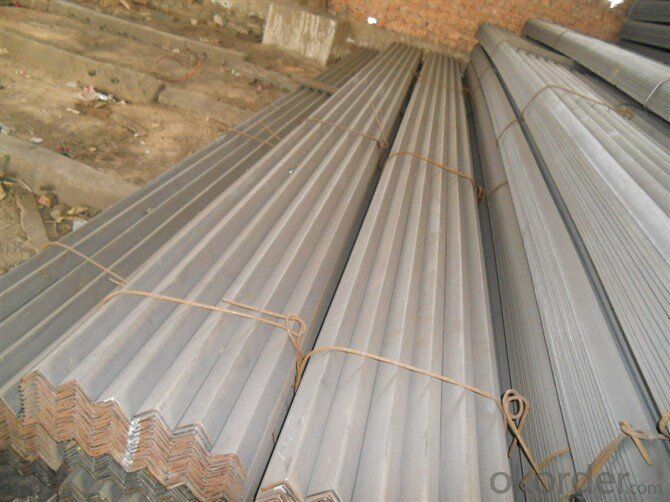
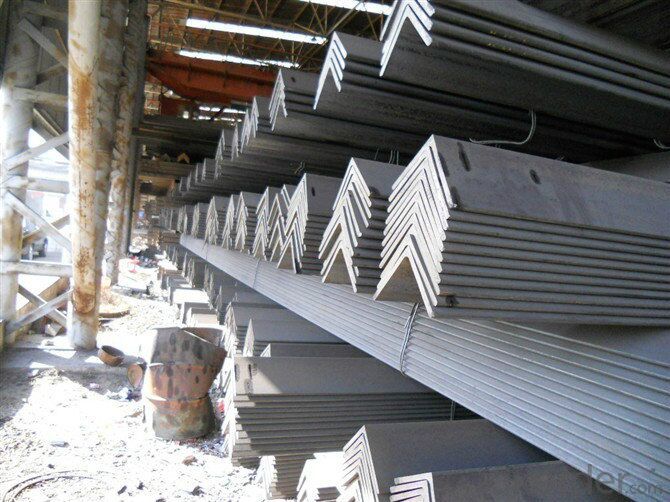
- Q: Are steel angles magnetic?
- Steel angles possess magnetic properties as they are made of steel, a ferromagnetic material. Ferromagnetic materials, like steel, can be magnetized and are drawn towards magnets. Due to the composition of steel, which includes iron and other elements, it exhibits a magnetic response. This characteristic finds practical applications in diverse fields, including construction, where steel angles are frequently employed to provide structural support.
- Q: How do you prevent warping of steel angles during fabrication?
- To prevent warping of steel angles during fabrication, several measures can be taken. Firstly, it is essential to ensure proper storage and handling of the angles to avoid any bending or twisting. During welding or heating processes, it is crucial to control the temperature and heat distribution evenly to prevent localized expansion or contraction that may lead to warping. Additionally, using proper clamping or fixturing techniques can help maintain the desired shape and prevent warping. Lastly, post-fabrication processes like stress relieving or annealing can be employed to release any residual stresses in the angles and minimize the risk of warping.
- Q: Can steel angles be used for framing or supporting suspended ceilings?
- Yes, steel angles can be used for framing or supporting suspended ceilings. Steel angles provide excellent structural support and can be easily attached to the walls or ceiling to create a sturdy framework for suspended ceilings. They are commonly used in construction and are known for their strength and durability, making them suitable for this purpose.
- Q: Can steel angles be used for pipe support systems?
- Indeed, pipe support systems can indeed utilize steel angles. In construction and engineering ventures, steel angles are frequently employed due to their exceptional durability, stability, and adaptability. When employed as pipe supports, steel angles furnish a robust and dependable framework for securely holding pipes in position. They can effortlessly be joined through welding or bolting to other structural elements, rendering them suitable for a variety of pipe support applications. Furthermore, steel angles can be fabricated and tailored to satisfy specific requirements, encompassing diverse pipe sizes and load-bearing capacities. In summary, owing to their resilience and capacity to withstand substantial loads, steel angles remain a favored option for pipe support systems.
- Q: Are there any industry standards or codes for steel angles?
- Steel angles are subject to industry standards and codes, which are established by various organizations in the steel industry. These standards and codes are put in place to guarantee the quality, safety, and dependability of steel angles used in different applications. The American Society for Testing and Materials (ASTM) A36 standard is widely acknowledged as one of the leading standards for steel angles. It outlines the requirements for carbon structural steel shapes, including angles, covering aspects such as chemical composition, mechanical properties, and dimensional tolerances. In addition to ASTM, there are other organizations like the American Institute of Steel Construction (AISC), British Standards Institution (BSI), and European Committee for Standardization (CEN) that have developed their own standards and codes for steel angles, catering to specific industries or regions. These industry standards and codes play a vital role in ensuring consistent quality and performance of steel angles, promoting safety, and facilitating effective communication between manufacturers, designers, and end-users.
- Q: What are the different types of connections used for steel angles in educational institutions?
- Steel angles in educational institutions can be connected using various methods. These connections play a crucial role in joining steel angles together for different applications and structural configurations. Here are some commonly used types of connections: 1. Welded Connections: Educational institutions often rely on welding to connect steel angles. This method involves melting and fusing the steel angles together using heat, resulting in a strong and durable connection. Welded connections are ideal for structural applications that require high strength and rigidity. 2. Bolted Connections: Another popular method is using bolts, nuts, and washers to secure steel angles. This type of connection allows for easy disassembly and reassembly, making it suitable for applications that require flexibility and adjustability. Non-structural applications like furniture, handrails, and brackets commonly employ bolted connections. 3. Riveted Connections: Riveting, an older connection method, involves joining steel angles using rivets. Rivets are inserted through pre-drilled holes in the angles and then hammered or compressed to secure the connection. Although less commonly used today, some older structures within educational institutions still employ riveted connections. 4. Clip Connections: Specially designed clips or brackets can be used to connect steel angles in clip connections. These clips are typically bolted or welded to the angles, providing a quick and efficient connection method. Clip connections find applications in areas where easy installation and maintenance are important, such as suspended ceilings or modular structures. 5. Gusset Plate Connections: Gusset plate connections utilize additional steel plates (gusset plates) to connect steel angles. These gusset plates are usually welded or bolted to the angles, enhancing the strength and stability of the connection. Heavy-duty structural applications like trusses or frames in educational institutions commonly employ gusset plate connections. The selection of the appropriate connection type for steel angles in educational institutions depends on factors such as load requirements, structural design, ease of installation, and maintenance considerations. It is crucial to consult with structural engineers and adhere to relevant building codes and regulations to ensure the usage of safe and suitable connections.
- Q: How are steel angles supported during installation?
- Various techniques and materials are typically utilized to support steel angles during installation. One popular approach involves employing steel brackets or supports specially designed to secure the angles in place. These brackets are commonly affixed to the structure using bolts or screws, effectively providing stability and structural integrity to the angles. Another means of support involves directly welding the steel angles to the structure. This entails employing a welding process to fuse the angles to the existing steel framework, guaranteeing a robust and secure connection. Welding is often the preferred method in situations where the angles bear heavy loads or require additional strength. Concrete or masonry may also be employed to support steel angles in certain cases. This method involves embedding the angles into the concrete or masonry structure, creating a solid and stable foundation for the installation. Construction projects often utilize this technique when secure fixation to the building or additional reinforcement is necessary. Ultimately, the specific method of supporting steel angles during installation depends on the project's requirements, the necessary load-bearing capacity, and the design specifications. It is crucial to adhere to the appropriate industry standards and guidelines to ensure a safe and successful installation.
- Q: Can steel angles be used in overhead crane or hoist systems?
- Indeed, overhead crane or hoist systems can indeed utilize steel angles. These structural components find widespread application in the construction of crane runways, support structures, and trolley rails. By furnishing a robust and inflexible framework for the crane or hoist system, steel angles prove their worth. Notably, their superior strength-to-weight ratio renders them an optimal selection for heavy-duty tasks. Furthermore, the convenience of welding or bolting steel angles together facilitates effortless installation and customization. All in all, steel angles offer a dependable and economically viable choice for integration into overhead crane or hoist systems.
- Q: Can steel angles be cut to custom lengths?
- Yes, steel angles can be cut to custom lengths.
- Q: What are the common methods of joining or connecting steel angles together?
- Common methods of joining or connecting steel angles together include welding, bolting, and using angle brackets or cleats.
Send your message to us
Supply Hot Rolled Angle Steel for Transmission Towers
- Loading Port:
- Tianjin
- Payment Terms:
- TT OR LC
- Min Order Qty:
- 25 m.t.
- Supply Capability:
- 20000 m.t./month
OKorder Service Pledge
OKorder Financial Service
Similar products
Hot products
Hot Searches
Related keywords
